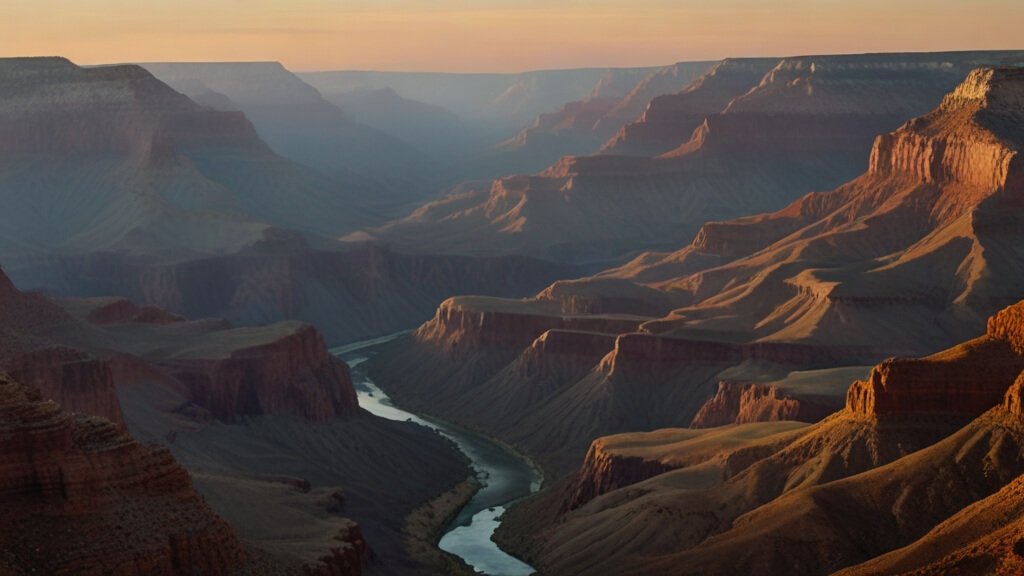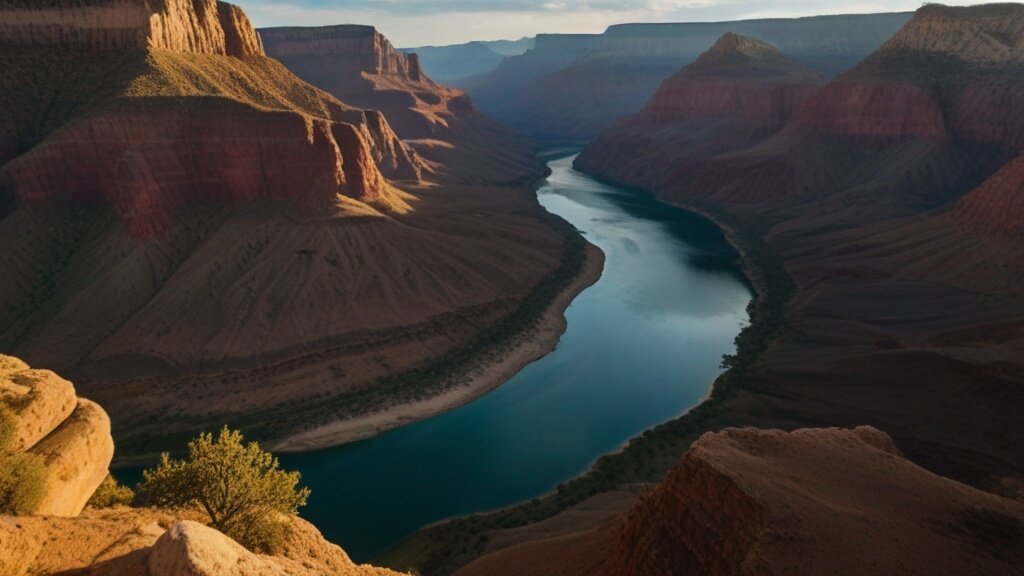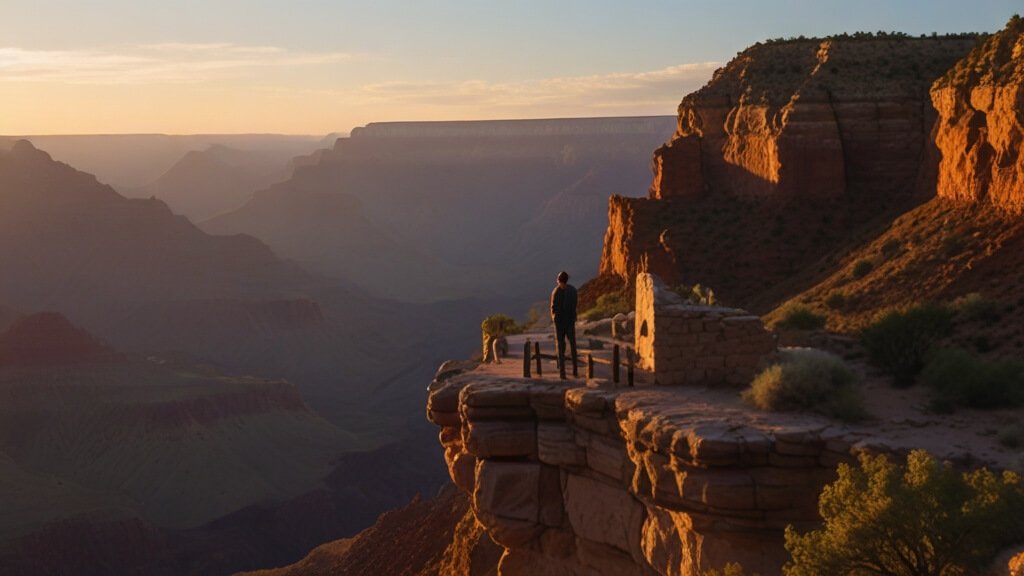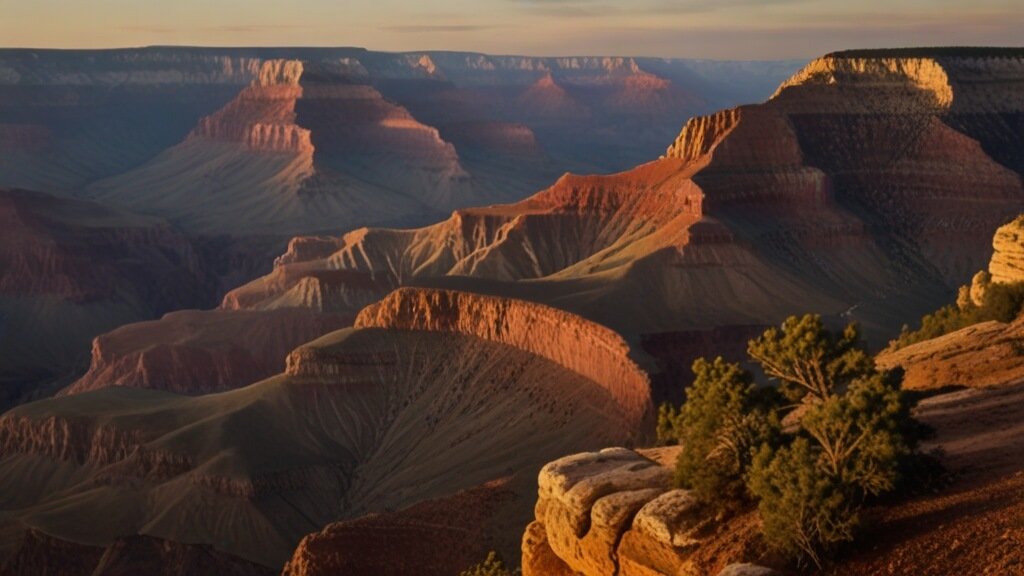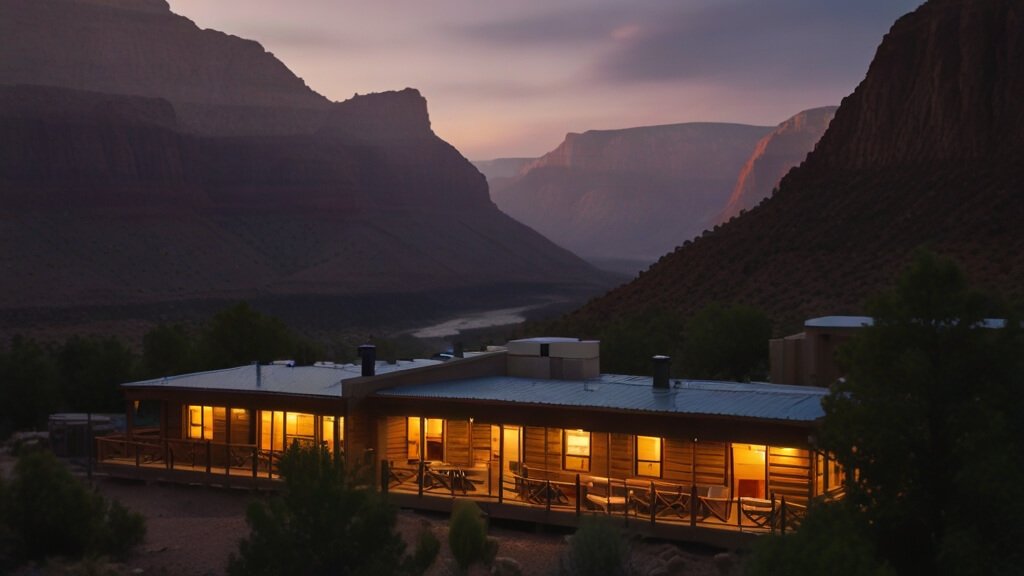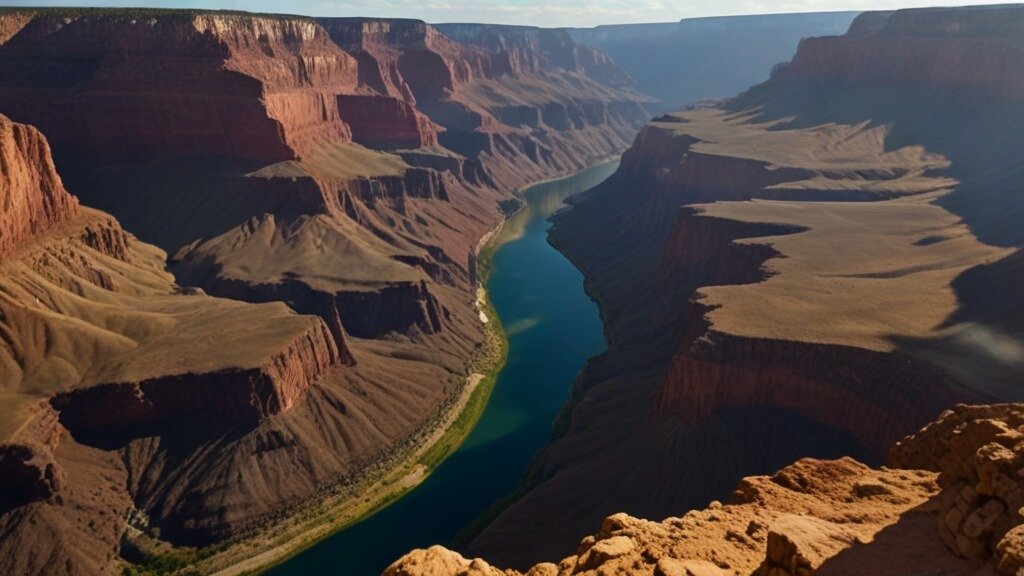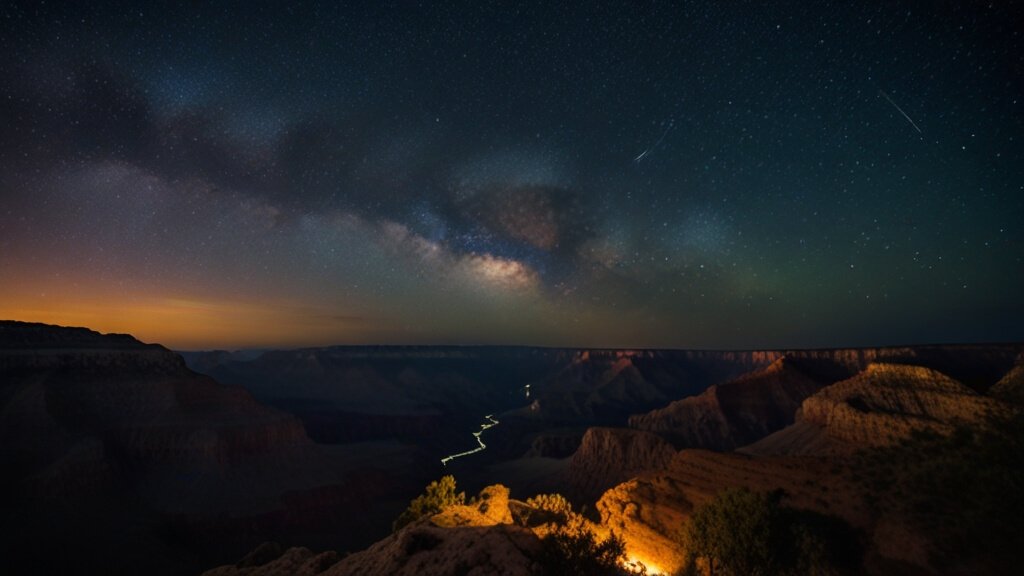Unveiling the Grand Canyon’s Majesty
Picture this: You stand on the edge of the Grand Canyon, the Colorado River winding its way through the immense chasm below. The sun paints the canyon walls in hues of red and orange, casting shadows that dance across the rugged terrain. It’s a moment that takes your breath away—a testament to the Earth’s geological history and the forces that shaped this natural wonder.
Whether you’re a seasoned hiker, a photography enthusiast, or simply seeking solace in nature, the Grand Canyon offers something for everyone. But how many days do you need to truly immerse yourself in its grandeur? Let’s find out.
How Many Days Do You Need at the Grand Canyon?
1. Two Days: The Essentials
For those on a tight schedule, a two-day Grand Canyon itinerary covers the essentials. Here’s what you can expect:
Scenic Views:
Spend your first day exploring the South Rim’s iconic viewpoints—Mather Point, Yavapai Point, and Desert View. Witness sunrise or sunset over the canyon; the play of light and shadow is mesmerizing.
- Mather Point: As the sun rises or sets, head to Mather Point on the South Rim. Here, the canyon reveals its grandeur—the layered rock formations, the meandering Colorado River, and the vastness that stretches beyond the horizon. The play of light and shadow paints the walls in hues of red, orange, and gold. It’s a moment that captures the essence of this natural wonder, leaving you in awe of the Earth’s geological history.
- Yavapai Point: Just a short walk from Mather Point, Yavapai Point offers a different perspective. Here, you can gaze into the heart of the canyon, tracing the river’s path as it carves through the ancient rock layers. The expansive vistas invite contemplation, and the sheer magnitude of the landscape leaves an indelible mark on your soul. Whether you’re a seasoned traveler or a first-time visitor, these scenic viewpoints are a testament to the timeless beauty of the Grand Canyon. 🌄🏞️
Remember, each viewpoint offers a unique experience, so take your time to soak in the breathtaking scenery and create memories that will last a lifetime. Happy exploring! 😊
Rim Trail:
Take a leisurely stroll along the Rim Trail, which offers breathtaking panoramas. It’s an easy hike suitable for all ages.
- Overview of Rim Trail: The Rim Trail is a scenic route that hugs the edge of the South Rim, stretching for approximately 13 miles (21 kilometers). It’s an accessible trail suitable for all ages and fitness levels. As you walk along the rim, you’ll be treated to jaw-dropping vistas—the vastness of the canyon, the layered rock formations, and the Colorado River winding its way below. The trail meanders through pine forests, rocky outcrops, and open viewpoints, each revealing a different facet of this natural wonder. Whether you choose to hike a short section or tackle the entire trail, the Rim Trail promises awe-inspiring views that will leave you spellbound.
- Must-See Points Along the Rim Trail:
- Mather Point: Start your journey at Mather Point, one of the most popular viewpoints. From here, you’ll witness the grandeur of the canyon—the sheer cliffs, the play of light on the rocks, and the distant peaks. Sunrise and sunset are particularly magical at Mather Point.
- Yavapai Point and Geology Museum: Continue to Yavapai Point, where interpretive displays provide insights into the canyon’s geology. The views here are equally captivating, allowing you to trace the river’s path and marvel at the eons of Earth’s history etched into the rock layers.
- Trail of Time: As you walk, keep an eye out for the Trail of Time markers—a geological timeline that spans 1.8 billion years. Each marker represents a significant event in the canyon’s formation. It’s like stepping back in time while surrounded by timeless beauty.
Remember to take your time, breathe in the fresh air, and let the immensity of the Grand Canyon envelop you. Happy trails! 🌄🏞️
Hermits Rest:
Hop on the free shuttle to Hermits Rest, where you’ll find more stunning vistas and the historic Hermit’s Rest cabin.
- Hermit’s Rest Overview: Hermit’s Rest is more than just a viewpoint; it’s a step back in time. Designed by architect Mary Colter in 1914, this rustic stone building was originally intended as a rest stop for weary travelers along the Hermit Road. Today, it serves as a testament to the early days of Grand Canyon tourism. As you approach Hermit’s Rest, the cozy cabin blends seamlessly with the rugged landscape. Its massive stone fireplace and wooden beams evoke a sense of warmth and nostalgia. Step inside, and you’ll find a gift shop where you can purchase souvenirs or grab a hot drink during the cooler months. But the real magic lies just outside—the panoramic views that stretch across the canyon, offering glimpses of the Colorado River winding far below. Whether you’re savoring a cup of coffee on the patio or simply taking in the vistas, Hermit’s Rest invites you to pause, reflect, and appreciate the timeless beauty of this natural wonder.
- Hermit’s Rest Trail: From Hermit’s Rest, a short trail leads to the edge of the canyon. The path winds through piñon pine and juniper trees, revealing glimpses of the abyss at every turn. As you descend, you’ll encounter viewpoints that allow you to peer into the heart of the Grand Canyon. Plateau Point, reachable via a longer hike, offers an even more intimate experience—the river seems close enough to touch. Hermit’s Rest Trail is a serene escape from the crowds, and the solitude allows you to connect with the landscape on a deeper level. Whether you’re a history buff, a nature lover, or simply seeking tranquility, Hermit’s Rest is a must-visit during your Grand Canyon adventure. 🌄🏞️
Remember to take your time at Hermit’s Rest, soak in the views, and appreciate the craftsmanship that went into creating this timeless gem. Happy exploring! 😊
Lodging:
Stay at one of the comfortable lodges within the park or nearby towns like Williams, Arizona.
- Lodging Options Within the Park: When it comes to staying within the Grand Canyon National Park, you have several options. These lodges offer proximity to the canyon’s rim, allowing you to wake up to breathtaking views:
- El Tovar Hotel: A historic gem, El Tovar Hotel sits right on the South Rim. Its rustic elegance and cozy rooms evoke a sense of nostalgia. Enjoy meals at the El Tovar Dining Room, where you can savor regional cuisine while gazing out over the canyon.
- Bright Angel Lodge: Located near the Bright Angel Trailhead, this lodge offers rustic cabins and motel rooms. The Buckey O’Neill Cabin, with its charming fireplace, is a favorite among visitors.
- Kachina Lodge and Thunderbird Lodge: These lodges are perched on the rim, providing stunning views. Imagine stepping outside your room and witnessing sunrise or sunset over the canyon—it’s an experience like no other.
- Nearby Towns for Accommodation: If you prefer more budget-friendly options or want to explore beyond the park boundaries, consider staying in nearby towns:
- Williams, Arizona: Just an hour’s drive from the Grand Canyon, Williams offers a variety of hotels, motels, and charming B&Bs. It’s a great base for exploring both the canyon and Route 66.
- Tusayan, Arizona: Located just outside the park entrance, Tusayan has several hotels and restaurants. It’s convenient if you’re looking for easy access to the canyon.
- Flagstaff, Arizona: About 80 miles (129 kilometers) from the South Rim, Flagstaff offers a wider range of accommodations. Plus, you can explore the city’s vibrant arts scene and enjoy its cool mountain climate.
Remember to book your lodging well in advance, especially during peak seasons. Whether you choose a historic lodge within the park or opt for a cozy room in a nearby town, your Grand Canyon experience begins the moment you step through the door. Happy travels! 🌄🏞️
2. Three Days: Hidden Gems and Longer Hikes
Extend your stay to three days for a deeper Grand Canyon experience:
Bright Angel Trail:
Embark on a day hike down the Bright Angel Trail. Marvel at the layered rock formations and perhaps glimpse a California condor soaring above.
- Trail Overview: The Bright Angel Trail begins near Grand Canyon Village on the South Rim and descends a staggering 4,380 feet (1,335 meters) to the Colorado River. As you hike, you’ll traverse billions of years of geologic history, with each step revealing stunning views into the depths of the canyon. The trail follows the Bright Angel Fault, offering hikers the chance to walk in the footsteps of Indigenous Peoples, miners, and early tourists who explored this awe-inspiring landscape. While the descent is challenging, the well-maintained trail provides an excellent introduction to inner canyon hiking. Along the way, you’ll encounter resthouses, vault toilets, and even drinking water during the summer months.
- Destinations Along the Trail:
- First Tunnel: Just 0.1 miles (0.2 kilometers) from the trailhead, you’ll find the First Tunnel. It’s a quick roundtrip detour that takes about 20 minutes. From here, you can already glimpse the grandeur of the canyon and feel the anticipation of the adventure ahead. As you continue deeper into the canyon, the views become even more breathtaking, rewarding your efforts with every step. Whether you’re a seasoned hiker or a first-timer, the Bright Angel Trail promises an unforgettable journey into the heart of the Grand Canyon.
Remember to bring plenty of water, wear sturdy hiking shoes, and take your time to savor the natural beauty that surrounds you. Happy trails! 🌄🏞️
Inner Canyon:
Explore the inner canyon—perhaps hiking to Plateau Point or Indian Garden. Be prepared for steep descents and challenging terrain.
- Hiking the Inner Canyon: The Inner Canyon is where the Grand Canyon’s true magic unfolds. You can experience it by hiking the various trails that descend from the rim. One such trail is the Bright Angel Trail, which begins near Grand Canyon Village on the South Rim. As you descend, the towering canyon walls envelop you, revealing layers of ancient rock formations. Each step takes you deeper into the Earth’s history, and the views become more awe-inspiring. Along the way, you’ll encounter resthouses, offering a chance to catch your breath and take in the breathtaking vistas. Whether you venture just a few miles down or tackle the entire Rim-to-Rim hike, the Inner Canyon promises an unforgettable journey—one that connects you intimately with the forces that shaped this magnificent landscape.
- Rafting the Colorado River: Another way to explore the Inner Canyon is by rafting down the mighty Colorado River. Starting at Lees Ferry, near the eastern end of the Grand Canyon, you can embark on a multi-day river adventure that takes you through the heart of the canyon. As you float downstream, the towering cliffs rise above you, revealing eons of geological history. You’ll encounter rapids, serene stretches, and hidden waterfalls. Along the way, keep an eye out for unique flora, wildlife, and the ever-changing colors of the canyon walls. Whether you’re hiking or rafting, the Inner Canyon invites you to step beyond the rim and immerse yourself in its timeless beauty—a journey that leaves an indelible mark on your soul. 🌄🏞️
Stargazing:
The Grand Canyon is a designated Dark Sky Park. Spend an evening stargazing; the lack of light pollution allows for incredible celestial views.
- The Dark Sky of the Grand Canyon: Imagine standing on the rim of the Grand Canyon, the cool night air embracing you. As the sun sets and darkness descends, the canyon transforms into a canvas of stars. The Grand Canyon is a designated Dark Sky Park, which means it offers minimal light pollution. This pristine environment allows stargazers to witness celestial wonders that are often obscured in urban areas. Look up, and you’ll see the Milky Way arching across the sky—a river of stars stretching from horizon to horizon. The constellations reveal themselves—the hunter Orion, the queen Cassiopeia, and the mythical Pegasus. Binoculars or a telescope enhance the experience, allowing you to spot distant galaxies, nebulae, and even planets. Whether you’re an amateur astronomer or simply someone who appreciates the beauty of the cosmos, stargazing at the Grand Canyon is a humbling and awe-inspiring activity.
- Tips for Stargazing:
- Choose the Right Spot: Head away from artificial lights. The South Rim viewpoints, such as Yaki Point or Desert View, offer unobstructed views of the night sky.
- Timing: The best stargazing occurs during moonless nights. Check the lunar calendar and plan your visit accordingly.
- Patience: Allow your eyes to adjust to the darkness. It takes about 20 minutes for your vision to adapt fully.
- Learn the Constellations: Download a stargazing app or bring a star chart. Identify Orion’s belt, the Big Dipper, and other prominent patterns.
- Contemplate the Cosmos: As you gaze upward, consider the enormity of the universe—the ancient light from distant stars reaching your eyes, the cosmic ballet unfolding silently above. It’s a moment of reflection, connecting you to the grandeur of existence itself.
So, wrap yourself in a warm blanket, lie back, and lose yourself in the celestial symphony above. The stars have stories to tell, and the Grand Canyon provides the perfect stage for this cosmic drama. 🌌✨
Frequently Asked Questions (FAQs) About How Many Days Do You Need at the Grand Canyon?
| Question | Answer |
|---|---|
| How many days should I spend at the Grand Canyon? | Most visitors find that 2 days are enough to see the popular sites and fit in some casual hikes. For those interested in longer hikes and hidden gems, consider scheduling 3 days. |
| What’s the best time to visit the Grand Canyon? | The spring and fall months offer pleasant weather and fewer crowds. Avoid the hot summer and cold winter extremes. |
| Can I visit the Grand Canyon as a day trip? | Yes, but it’s better to spend at least 2 days to fully appreciate its beauty. |
| Are there dams in the Grand Canyon? | No, but several dams bordering the park affect the Colorado River. |
| How old is the Grand Canyon? | The Grand Canyon is estimated to be around 6 million years old. |
| How big is the Grand Canyon? | It covers over 1 million acres of land and is 277 miles long along the Colorado River. |
| Do I need a permit to hike into the Grand Canyon? | Yes, for overnight stays below the rim. |
| What’s the difference between the South Kaibab Trail and the Bright Angel Trail? | The South Kaibab Trail is steeper and shorter, while the Bright Angel Trail is longer but offers more water sources. |
| Can I bring my dog if I hike into the canyon? | Dogs are not allowed below the rim due to extreme conditions. |
| How hard is it to hike into the Grand Canyon? | It can be challenging due to steep descents and elevation changes. |
| When did the Grand Canyon become a National Park? | It was designated a National Park in 1919. |
| How do I get to the Grand Canyon? | The South Rim entrance is accessible via route 64, while the North Rim is accessed via Highway 67. |
| What are the hazards in the Grand Canyon? | Hazards include extreme temperatures, dehydration, and rugged terrain. |
| How much does it cost to enter Grand Canyon National Park? | Entrance fees vary; check the official website for current rates. |
| What advice do you have for international visitors? | Plan ahead, stay hydrated, and respect the environment. |
| Where can I camp in Grand Canyon National Park? | There are several campgrounds both on the South Rim and the North Rim. |
| When does the North Rim close? | The North Rim is closed from December 1st through May 15th. |
| What activities are available at Grand Canyon National Park? | Hiking, rafting, stargazing, and scenic drives are popular activities. |
| Are the oldest rocks in the world exposed at the Grand Canyon? | No, but they are some of the oldest in North America. |
| How wide is the Grand Canyon? | At Grand Canyon Village, it’s 10 miles wide (rim to rim), but in places, it can be as wide as 18 miles. |
Remember to plan your visit based on your interests and the time you have available. Happy exploring! 🌄🏞️
Pre-Trip Checklist for Grand Canyon Itinerary
Clothing (All Seasons):
- Layered Clothing:
- Lightweight, moisture-wicking base layers
- Insulating mid-layers (fleece or down)
- Waterproof and windproof outer layers (jacket and pants)
- Sun-protective clothing (long-sleeve shirts, wide-brimmed hat, sunglasses)
- Footwear:
- Sturdy hiking boots with ankle support
- Comfortable socks (wool or synthetic)
- Sandals or camp shoes for relaxing at camp
- Headwear:
- Wide-brimmed hat for sun protection
- Beanie or hat for cooler evenings
- Gloves:
- Lightweight gloves for sun protection
- Insulated gloves for colder weather
- Accessories:
- Buff or neck gaiter (versatile for sun, wind, and cold)
- Bandana (multiple uses)
Additional Miscellaneous Items:
- Sunscreen and Lip Balm:
- High SPF sunscreen to protect against intense sun exposure
- Lip balm with SPF
- Insect Repellent:
- Keep those pesky bugs away!
- Personal Medications and First Aid Kit:
- Any necessary prescription medications
- Basic first aid supplies (bandages, antiseptic, pain relievers)
- Toiletries:
- Toothbrush, toothpaste, and biodegradable soap
- Wet wipes (useful for quick clean-ups)
- Reusable Water Bottle and Hydration System:
- Stay hydrated! Consider a filtration water bottle for refilling from natural sources.
- Camera or Smartphone:
- Capture the stunning views!
Hiking-Specific Items:
- Backpacking Backpack (60+ Liters):
- Choose a comfortable backpack with proper support for longer hikes.
- Headlamp or Flashlight:
- Essential for early morning or late-night hikes.
- Trail Maps and Compass/GPS:
- Know your route and stay on track.
- Multi-Tool or Knife:
- Handy for various tasks.
- Trekking Poles:
- Reduce strain on your knees during steep descents.
- Emergency Whistle and Signal Mirror:
- In case of emergencies.
- Lightweight Cooking Gear (if camping):
- Stove, cookware, and utensils
- Sleeping Bag and Sleeping Pad (if camping):
- Choose based on the season and expected temperatures.
- Permits and Reservations:
- Check if you need permits for camping or specific trails.
Remember, the Grand Canyon’s weather can be unpredictable, so be prepared for sudden changes. Pack smart, stay safe, and enjoy the breathtaking beauty of this natural wonder! 🌄🏞️
Embrace the Grandeur
As we bid farewell to the sun-kissed cliffs and the whispering winds of the Grand Canyon, let’s recap the essential insights from our journey:
- Time Matters: Whether you have 2 days or 3 days, the Grand Canyon will leave an indelible mark on your soul. Choose wisely, but remember that even a brief encounter with this natural wonder is worth cherishing.
- Layers of Beauty: Just as the canyon reveals its ancient rock layers, peel back the layers of your own experience. From sunrise vistas to stargazing nights, each moment adds depth to your memories.
- Costs and Comfort: Plan your budget for lodging, meals, and transportation. Whether you cozy up in a historic lodge or camp under the stars, find your comfort zone.
- Stargaze and Reflect: When the night sky unveils its celestial tapestry, let your thoughts wander. Contemplate the vastness, the eons, and your place in this cosmic dance.
🌄 Book Your Adventure! 🌄
Don’t let this guide be just words on a screen. Take action! Book your trip to the Grand Canyon. Share this article with fellow adventurers. Leave a comment below, sharing your favorite memory or tips for future travelers. And if you haven’t already, subscribe to our newsletter for more travel inspiration.
Remember, the Grand Canyon isn’t just a destination; it’s an invitation—to explore, to wonder, and to connect with the Earth’s ancient heartbeat. So pack your bags, follow the trails, and let the canyon embrace you. Happy trails, fellow wanderer! 🌟🏞️
Read More

